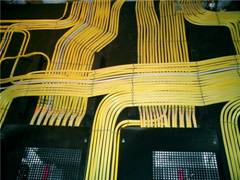Short circuit failures with 12/3 NM-B cable and NM clamp connectors
 Dear Mike,
Dear Mike,
I would like to bring to your attention a repeatable, hazardous fault arising from the combination of two common products UL listed for use in residential electrical wiring. This does not appear to be an inherent fault in the products, but rather an incompatibility that may require industry cooperation for resolution.
Fault Description
From informal testing it turns out that securing NM-B cable to a metal junction box through a standard metal 3/8” NM cable clamp connector creates the risk that even slight over-tightening of the clamp’s retaining screws will generate an immediate or subsequent short circuit fault between one or more conductors and box ground. This fault is 100% reproducible if the screws are sufficiently tightened, though there is some variability in the pressure required depending upon the alignment of this radially asymmetric cable with respect to the clamp connector.
Issues with excessive clamping force on Type-NM cable are not unknown. John Cangemi, in the UL publication THE CODE AUTHORITY®: ELECTRICAL CONNECTIONS, May 2005 issue writes:
Installer awareness of “securement, without damage” is a concern with regard to the satisfactory installation of Type NM cable, regardless of the outside diameter. Care should be taken when tightening clamps or driving staples – tighter is not always better.
While this is excellent general guidance, it does not appear to be sufficient in the situation I have outlined above. The specific problem is that the margin between insufficient clamping force and excessive clamping force can be small or non-existent with these specific components. Again under informal testing, there is no perceivable force-feedback cue to the installer that the clamping screws are sufficiently tight. One traditional test has been to wiggle the wire outside the box, tightening the clamp screws until the wire no longer moves inside the box. Informal testing shows that at this clamping force the cable has already shorted or been irreparably damaged.
Analysis
This fault appears to be easily reproducible only with 12/3 cable and this particular style of metal NM cable clamp connectors. Cable with fewer conductors, such as 12/2 and 14/2, is flatter and has a natural alignment to the clamp connector that restricts the maximum force on the cable. Smaller cable, such as 14/3, is not crushed as much by the cable clamp at its maximum closure. We made no evaluation of combinations of cable, such as two 14/2 cables.
The testing methodology was to measure low-voltage short circuits. It appears likely that cable damage occurs even with clamping force below that required to cause low-voltage shorts. Such cable damage may result in a lowered dielectric strength of the insulation, increasing the vulnerability to an arc short-circuit failure from high-voltage transients. It’s also possible that both cable sheath and individual conductor insulations will yield to this clamping force over time, leading to apparently random failures years after the initial installation. In one testing case the failure occurred only after some minutes past the application of clamping force, though this cannot be strictly attributed to plastic creep as opposed to subtle movement of the cable.
The clamp connector consists of a cast, threaded frame with a stamped plate attached by two screws. The plate is embossed with a dimple, apparently designed to provide an increased peak retention force for small-diameter cables. Examination of failed cables shows that this dimple is the source of penetration into the conductors. Experimentally flattening this dimple eliminated the failures, as did bending the plate such that the minimum opening at the fully screwed-down position was increased from approximately 4 mm to about 5 mm.
Some anecdotes of similar failures are available on the Internet using Google, including one at www.mikeholt.com. That the problem is not more widely reported may be due in part to common use of alternative NM cable connectors and limited use of 12/3 cable.
From my limited personal experience, this failure did not occur with older Type NM cable using metal clamp connectors. The older cable was of larger diameter and provided more resistance feedback to the installer as the screws were tightened.
Recommendations
My ethical responsibilities as a member of the IEEE require that I report this problem as a potential hazard to the public. However I have neither the authority nor expertise to make a specific recommendation for appropriate mitigation of this hazard. However it does seem obvious that 12/3 cable and standard metal 3/8” NM cable clamp connectors should not be used together. Alternative non-metallic clamp connectors are widely available.
Best regards,
Richard Zulch
President
Zulch Laboratories, Inc.